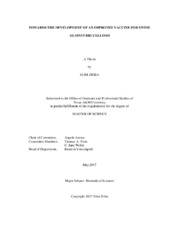| dc.contributor.advisor | Arenas, Angela | |
| dc.creator | Zriba, Slim | |
| dc.date.accessioned | 2017-08-21T14:46:47Z | |
| dc.date.available | 2019-05-01T06:08:37Z | |
| dc.date.created | 2017-05 | |
| dc.date.issued | 2017-05-04 | |
| dc.date.submitted | May 2017 | |
| dc.identifier.uri | https://hdl.handle.net/1969.1/161643 | |
| dc.description.abstract | Swine brucellosis is a zoonotic disease with variable incidence rates in domestic and feral populations. It is a serious public health issue due to the potential for spillover not only between infected feral and domestic swine but also cattle and humans. Previous studies published by our laboratory has demonstrated the cross-protective immunity elicited by the S19ΔvjbR live attenuated vaccine in mice against challenge with B. abortus, B. melitensis or B. suis, suggesting its potential use as a vaccine against multiple Brucella species. To date there is no effective vaccine used to prevent brucellosis in swine. This prompted us to study the potential use of S19 ΔvjbR as a vaccine candidate in this natural host by evaluating its safety and humoral response in pregnant swine. Fifteen pregnant gilts at fifty days of gestation (midgestation) were divided into four groups and vaccinated subcutaneously with 1X10^10 CFU of either; 1) strain S19; 2) S19ΔvjbR encapsulated in alginate microspheres 3) unencapsulated S19ΔvjbR, or 4) empty capsules as a control. Interestingly, none of the animals vaccinated with either S19 or S19ΔvjbR aborted or demonstrated any adverse side effect associated with vaccination. No bacteria was recovered from any of the tissues examined supporting the lack of histopathological changes in major organs either in piglets or in gilts. Vaginal swab culture from vaccinated animals showed no bacterial growth on Farrell’s agar medium. RBT and IgG iELISA tests were found substantial at 2 week (k= 0.8) and 4 week (k=0.65) post-vaccination suggesting that RBT can be used during this interval as a good tool to confirm the immunization of animals with the different vaccine strains. Different responses of gilts sera against purified vjbR protein at pre-vaccination and two week post-vaccination raised the question of specificity of the vjbR as marker and its inability to validate DIVA capabilities of the ΔvjbR vaccine candidates. | en |
| dc.format.mimetype | application/pdf | |
| dc.language.iso | en | |
| dc.subject | Abortion | en |
| dc.subject | brucellosis | en |
| dc.subject | vaccination | en |
| dc.subject | iELISA | en |
| dc.subject | Western blot | en |
| dc.subject | Rose Bengal Test | en |
| dc.subject | DIVA | en |
| dc.subject | ΔvjbR | en |
| dc.title | Towards the Development of an Improved Vaccine for Swine Against Brucellosis | en |
| dc.type | Thesis | en |
| thesis.degree.department | Veterinary Pathobiology | en |
| thesis.degree.discipline | Biomedical Sciences | en |
| thesis.degree.grantor | Texas A & M University | en |
| thesis.degree.name | Master of Science | en |
| thesis.degree.level | Masters | en |
| dc.contributor.committeeMember | Ficht, Thomas A. | |
| dc.contributor.committeeMember | Welsh, C. Jane | |
| dc.type.material | text | en |
| dc.date.updated | 2017-08-21T14:46:47Z | |
| local.embargo.terms | 2019-05-01 | |
| local.etdauthor.orcid | 0000-0002-0534-8554 | |


